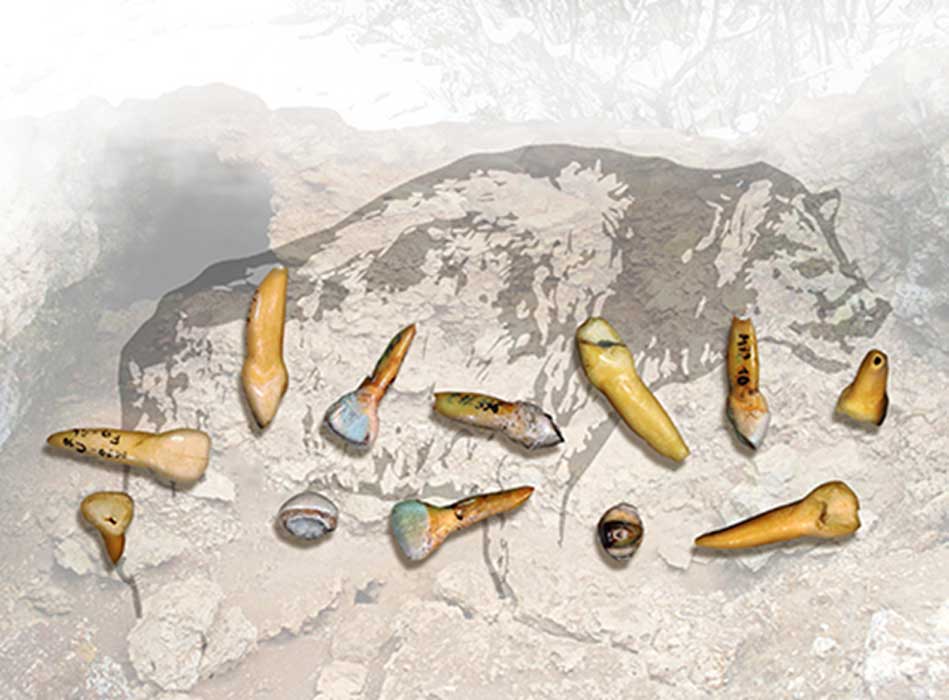Were Cannibal Leftovers Really Swallowed by an Ancient Hyena?
About 65,000 years ago, a large carnivore, probably a hyena, consumed someone’s face, new scientific data published this week has proven. And, according to the scientists who made this discovery, that face, might already have been consumed - by his family and friends.
Two incisor teeth were discovered at a renowned archaeological site near the village of Marillac-le-Franc, in the west of France, where since 1967 archaeologists have recovered tens of thousands of Neanderthal and animal remains from a cave dating back to the Pleistocene era. Neanderthals were modern human's closest relatives and went extinct about 40,000 years ago.
- Archaeologists Find Medieval Dentures Made from the Teeth of Dead People
- 9.7 Million-Year-Old Teeth Found in Germany Belong to Hominin Only Known To Have Existed in Africa 4 Million Years Later
- Study dismisses remarkable Neanderthal flute as the work of hyenas

Marillac-le-Franc archaeological site, France. (Image: PACEA Laboratory)
Until now, based on aesthetics alone, scientists “assumed” that the two teeth belonged to an ancient deer or other animal. Researchers at the Center for Scientific Research in France re-examined the teeth and found that although they are deformed, they belonged to a Neanderthal. The study, published in the American Journal of Physical Anthropology explains how this misinterpretation occurred and Bruno Maureille, director of research at the National Center for Scientific Research (CNRS), in Paris, told Live Science this week “when the large carnivore partially digested the teeth, the animal's digestive juices altered the chompers shape, making them difficult to identify.”

Detail of partly digested teeth. (Image: PACEA Laboratory)
With the teeth now proven as Neanderthal, and having been damaged by a carnivore’s digestion acids, you would think the case book would be closed on this story, right? But no, quite the opposite has happened. The mystery has deepened tenfold.
Over 17,000 reindeer, horse and bison bones have been found in the cave indicating to archeologists that it was a designated butchering area in an ancient hunters’ camp. In 2015 Science Daily reported that strewn among the butchered animal bones, Neanderthal bones were found with “similar butchery marks, indicating cannibalism.” Maureille said this week that it might be the case the Neanderthals ritually consumed the hominin bones, “or perhaps to practice butchery in general, study co-researcher Alan Mann, a professor emeritus of anthropology at Princeton University, told Live Science.

Cut marks observed on the femur of the Neanderthal child. Credit: M.D. Garralda et al, Science Daily)
Cannibalism is one of the most controversial issues in the study of archaeology and anthropology. In the American Southwest archaeologists found “disarticulated, cut-marked and heat-altered human remains from non-burial contexts” at prehistoric Puebloan (Anasazi) archaeological sites, according to a paper on nature.com. Because these disarticulated bodies were processed in “a manner consistent with food preparation” some scholars interpret this as evidence of cannibalism. On the other hand, opponents of the theory pointed out that “non-cannibalistic practices” might account for the assemblages, according to the scientist in the nature.com paper. Although osteological evidence alone did not prove the ingestion of human flesh, what did, was the discovery of preserved human waste containing human tissue remains, from a site with osteological evidence of cannibalism.
- Our Ancestors Were Cannibals – and Probably Not Because They Needed the Calories
- Skull Cups and Chewed Bones: Cannibalism was Ritual Behavior during Stone Age say Researchers
- Prehistoric Britons Cannibalized Dead Relatives and Created Art with their Bones

Evidence for the occurrence of cannibalism: the complete collection of human bones from Room 2 of the AD 1150–1200 Anasazi pueblo Houck K, in Arizona. (Image: Talk of Cannibalism).
Regarding the two teeth discovered in France, Mann added, "We don't know exactly what was going on, but [the Neanderthals] must have left skulls or parts of the face there, because cave hyenas came in and ate them.” If indeed the carnivore was a hyena, it was “the much larger, now-extinct variety that lived in ancient Europe,” Maureille commented. He added, “at that time, it was probably the most dangerous carnivore in Western Europe…and when you see the size of a hyena mandible, it is something that is more than impressive.”
Nohemi Sala, a postdoctoral researcher from the Joint Center for Research into Human Evolution and Behaviour at the Complutense University of Madrid, told Live Science in an email “the finding shines light on new cases of interaction between human and carnivores in Paleolithic times," which is important in that "humans and carnivores compete for the same prey, shelter (caves and rock-shelters), territories, and resources. Sala was not involved in the study.

A. Mann et B. Maureille study a Neanderthal femur. Image: PACEA Laboratory)
With all this talk of folk eating one and another, I find it alarming that nowhere in the archaeologist’s paper, press release, or in any of the articles covering this discovery, has anyone pointed out the “more probable” solutions to this mystery. Just because bones have been discovered with marks and grooves, indicating cannibalism, doesn’t mean cannibalism actually occurred. After death, a hunter’s bones might have been ritually cleaned before being burned. Personal injuries endured on the hunt caused by flint blades, similar to those used in the butchery cave, might also account for the marks in the bones.
But above all other theories, which was alluded to at the end of a National Geographic report this week, is that a hyena simply ate a hunter, and his teeth came out of the hyena when it was itself hunted down and put to the butchering cave. A 2015 study of Neanderthal bones found in Spain had been punctured by the fangs of a big ancient cat, so, it would appear that in their battle for existence against modern humans, cave dwelling Neanderthals had bigger, more immediate problems to deal with.
Top image: Hyena and Neanderthal teeth on hyena background. Image Credit: Collage by G. Delvider/UMR PACEA CNRS, Rights Pradelles excavation team PACEA Laboratory
By Ashley Cowie

















